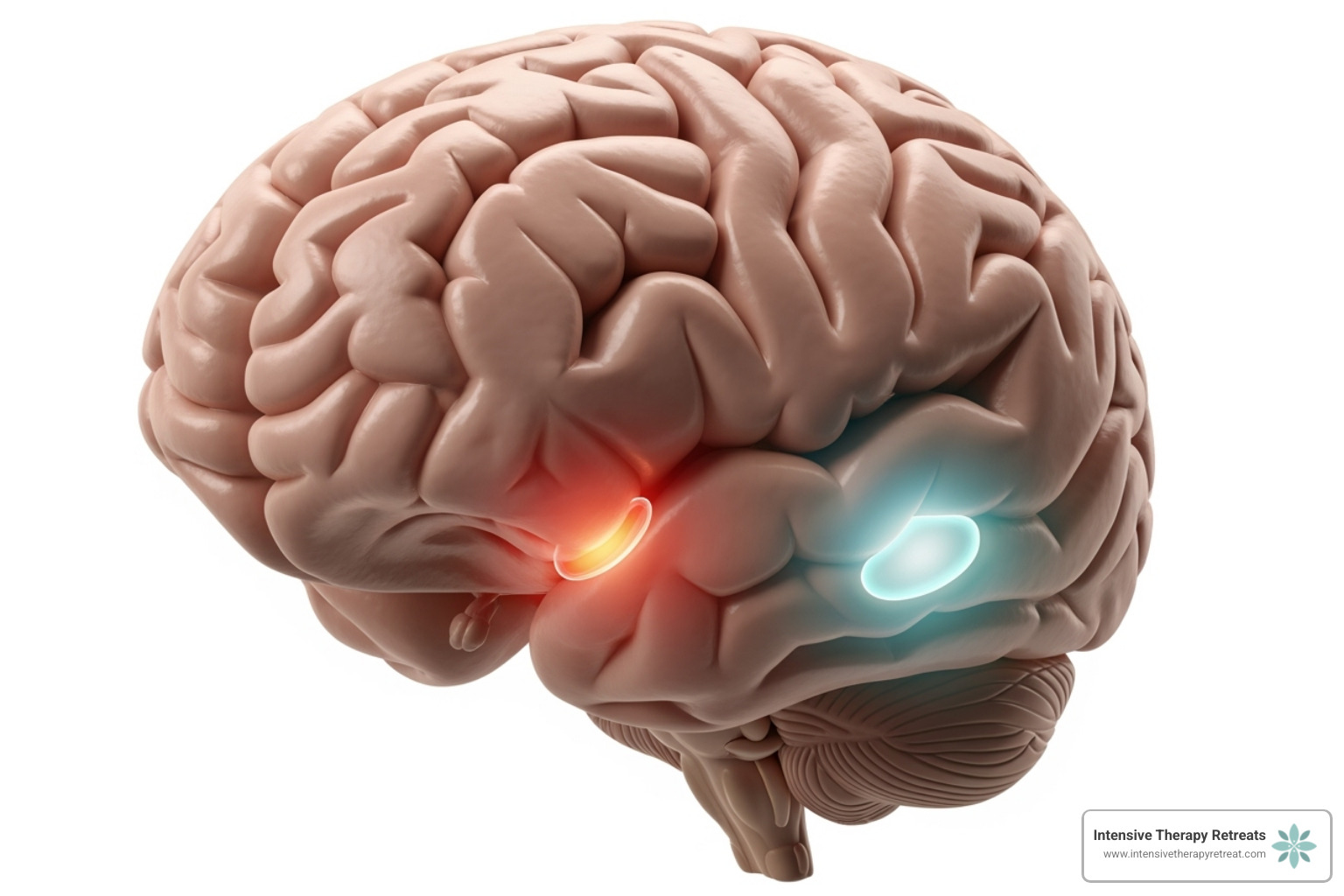Understanding What Happens During Your Trauma Therapy Journey
What do people do in therapy sessions for trauma varies based on the therapeutic approach and individual needs, but most sessions involve a combination of these core activities:
- Psychoeducation: Learning about trauma’s impact on the brain and body.
- Skill-building: Developing coping strategies and emotional regulation techniques.
- Memory processing: Working through traumatic memories with specialized techniques.
- Somatic work: Addressing trauma stored in the body through movement and awareness.
- Cognitive restructuring: Challenging and reframing negative beliefs.
- Safety planning: Creating strategies to manage triggers and difficult moments.
With around 70% of U.S. adults having experienced at least one trauma, many feel uncertain about what happens in therapy. The journey from surviving to thriving isn’t mysterious; it’s a structured process combining evidence-based techniques with your own resilience.
While not a mental health condition itself, trauma can lead to disorders like PTSD. When experiences overwhelm your nervous system, they can get “stuck,” creating symptoms like flashbacks, hypervigilance, or depression. The good news is that your brain has an incredible capacity to heal in a supportive environment.
I’m Bambi Rattner, Psy.D., and for over three decades, I’ve helped people heal using approaches like EMDR and intensive retreat models. My experience shows that healing is most effective when clients have dedicated, immersive time to work through their trauma in a supportive setting.
Find more about what do people do in therapy sessions for trauma:
- childhood trauma therapy session
- explanation of 2 person trauma focused therapy session ptsd
- questions for trauma focused therapy session ptsd
Understanding Trauma’s Footprint on Your Mind and Body
When we ask what do people do in therapy sessions for trauma, we must first understand what we’re dealing with. Trauma isn’t defined by the event, but by its impact on your nervous system, which can get stuck in a state of high alert.
This dysregulation is not your fault or a sign of weakness; it’s a natural brain response to overwhelming experiences. Since around 70% of adults in the United States have experienced at least one trauma, you are not alone. Understanding how trauma affects your brain and body is the first step toward healing.
When trauma occurs, your brain’s fear center (the amygdala) goes into overdrive, while the memory center (the hippocampus) struggles to file the event properly. This creates fragmented memories that feel like you’re reliving the experience. Your body also keeps the score, with the fight, flight, or freeze response getting stuck, leading to chronic tension, digestive issues, and sleep problems.
The Different Forms Trauma Can Take
Understanding trauma’s different forms helps clarify why therapy varies from person to person.
- Acute trauma results from a single, overwhelming event like an accident or assault.
- Chronic trauma develops from repeated exposure to highly stressful situations, such as ongoing domestic violence or bullying.
- Complex trauma arises from multiple traumatic events, often starting in childhood and involving a caregiver, which deeply affects trust and emotional regulation.
People also refer to “Big T” trauma (life-threatening events) and “small t” trauma (personally distressing experiences). The label isn’t as important as how the event affected you.
Common Signs and Symptoms of Unresolved Trauma
Recognizing trauma’s impact is empowering. Symptoms can manifest in several ways:
- Emotionally and Psychologically: You might experience chronic sadness, anger, fear, or numbness. Flashbacks, nightmares, intrusive thoughts, and memory gaps are common. You may feel disconnected or like you’re living in a constant state of dread.
- Physically and Behaviorally: Trauma can cause chronic fatigue, unexplained pain, digestive issues, and sleep problems. You might find yourself avoiding people or places that remind you of the trauma, leading to isolation. Some people become more impulsive, while others withdraw socially.
- In Relationships: Trust can feel impossible, leading to intimacy issues or repeating unhealthy patterns. A persistent feeling of being misunderstood can create a lonely cycle.
Understanding these responses is the foundation for what do people do in therapy sessions for trauma to begin healing.
The Foundation of Healing: Creating a Safe Therapeutic Space
Before any deep work can begin, trauma therapy must build a solid foundation of safety. When people ask what do people do in therapy sessions for trauma, the answer always starts with creating an environment where healing is possible.
This is the core of Trauma-Informed Care (TIC), a philosophy that shifts the question from “What’s wrong with you?” to “What happened to you?” This acknowledges that your struggles are a valid response to your experiences. Building trust is central, as your therapist provides a reliable, non-judgmental presence, which can be a powerful corrective experience in itself.
Trauma-Informed vs. Trauma-Specific Therapy
It’s helpful to understand two key concepts:
- Trauma-Informed Care is the overall approach that recognizes trauma’s impact. It’s the safe container ensuring you are treated with respect and understanding in every interaction.
- Trauma-Specific Therapy refers to the targeted tools and evidence-based practices (EBPs) like EMDR or Internal Family Systems used to heal trauma’s wounds. It’s the medicine inside the safe container.
Both are essential. The trauma-informed environment creates the safety needed to effectively use trauma-specific techniques without feeling overwhelmed.
Core Principles of a Safe Healing Environment
Six core principles guide a trauma-informed approach, creating the conditions for recovery:
- Safety: Ensuring you feel physically and emotionally secure.
- Trustworthiness and Transparency: Explaining the process clearly and honestly.
- Peer Support: Recognizing the healing power of connecting with others with similar experiences.
- Collaboration and Mutuality: Making you an active partner in your healing journey.
- Empowerment, Voice, and Choice: Respecting your autonomy and preferences.
- Cultural, Historical, and Gender Issues: Understanding how your identity and background influence your needs.
What Do People Do in Therapy Sessions for Trauma? A Look at Key Techniques
When we explore what do people do in therapy sessions for trauma, we find a dynamic process of learning, skill-building, and deep psychological work. The journey involves understanding trauma’s effects, developing skills to manage emotions, and processing traumatic memories so they no longer control your life.
At Intensive Therapy Retreats, we use proven methods like EMDR, Internal Family Systems (IFS), and Accelerated Resolution Therapy (ART) in an immersive setting. This dedicated focus helps you achieve significant healing in days, rather than months or years.
More info about trauma therapy services
Cognitive Therapies: Reshaping Your Narrative
Cognitive therapies like Cognitive Behavioral Therapy (CBT) and Cognitive Processing Therapy (CPT) work on the principle that our thoughts, feelings, and behaviors are linked. Trauma often creates negative thought patterns that perpetuate distress. CPT, for example, focuses on changing upsetting thoughts related to the trauma, such as self-blame or the belief that the world is unsafe. In a structured format, often over 12 sessions, you learn skills to evaluate and challenge these “stuck points,” allowing you to reframe your story and build resilience.
Somatic and Body-Based Approaches: Reconnecting with Your Physical Self
Since “the body keeps the score,” somatic therapies are crucial for releasing the physiological residue of trauma. Techniques like Sensorimotor Psychotherapy (SP) and Somatic Experiencing (SE) focus on bodily sensations and impulses. Instead of just talking about the event, you learn to notice and process physical tension. This helps complete the natural “fight, flight, or freeze” responses that were interrupted, allowing your nervous system to understand that the danger has passed and it’s safe to relax.
Reprocessing Therapies: How to Heal the Brain’s Memory Storage
Some of the most effective trauma therapies focus on how the brain stores memories. When a memory is improperly stored, it causes ongoing distress. Reprocessing therapies help the brain file these memories correctly, reducing their emotional charge.
Eye Movement Desensitization and Reprocessing (EMDR)
EMDR therapy helps the brain reprocess traumatic memories using its natural healing ability. In a session, you’ll focus on a distressing memory while engaging in bilateral stimulation (BLS)—typically therapist-guided eye movements. This dual attention helps reduce the memory’s vividness and emotional charge without requiring you to talk about the event in detail. EMDR is recognized as a best practice for treating PTSD by organizations like the US Department of Veterans Affairs.
Internal Family Systems (IFS)
IFS therapy views our personality as being made up of various “parts” and a core “Self.” Trauma can cause parts to take on extreme roles to protect us. In IFS, you connect with your wise, compassionate Self to understand these parts. By approaching anxious or pained parts with curiosity, you can help them release their burdens. This fosters internal harmony and self-compassion, often involving “inner child work” to heal past wounds.
Accelerated Resolution Therapy (ART)
ART is a powerful, evidence-based treatment that can provide relief from trauma in as few as one to three sessions. Recognized by SAMHSA, ART uses eye movements to help you “reprogram” how your brain stores traumatic memories. The goal is to change the distressing images associated with the memory into more positive ones, quickly reducing the emotional and physical reactions without extensive discussion of the event.
More info about Accelerated Resolution Therapy
Navigating Your Trauma Therapy Journey
Starting trauma therapy takes courage. Knowing what to expect can transform anxiety into empowerment. While healing isn’t a straight line, it’s a journey toward greater peace and freedom from the past.
What to Expect in Your First Trauma Therapy Sessions
Your first few sessions are about building a foundation of safety, not diving into painful memories. The process typically includes:
- Initial Assessment: Your therapist will learn about your history, symptoms, and how trauma impacts your life to create a roadmap for healing.
- Building Rapport: The focus is on creating a welcoming space where you feel heard and understood. A skilled trauma therapist moves at your pace.
- Setting Goals: You’ll work together to define what you hope to achieve, whether it’s better sleep, less anxiety, or fewer triggers.
- Learning Coping Skills: You’ll be taught grounding techniques and breathing exercises early on to serve as a safety net for the deeper work ahead.
- Creating a Treatment Plan: Based on your assessment and goals, your therapist will outline the recommended approach. You always have the right to pause if things feel overwhelming.
The Typical Structure and Duration of What People Do in Therapy Sessions for Trauma
The structure of trauma therapy varies, but understanding the framework helps set expectations. Sessions typically last 50 to 90 minutes to allow enough time for processing.
The choice between weekly sessions and intensive models can dramatically impact your healing. While traditional therapy occurs weekly over months or years, intensive models are highly effective. At Intensive Therapy Retreats, our immersive approach allows for focused work over several days, helping you achieve breakthroughs much faster than in conventional therapy.
Treatment duration depends on the trauma’s complexity and the chosen therapy. CPT often involves 12 weekly sessions, while ART can bring relief in just 1 to 3 sessions. Your commitment to the full treatment process is crucial for lasting change, as stopping midway can leave you more vulnerable.
Finding the Right Trauma Therapist for You
Finding the right therapist is a critical step. It’s about both credentials and personal connection.
- Credentials and Specializations: Look for licensed professionals (psychologists, social workers, counselors) who specialize in trauma and are trained in evidence-based therapies like EMDR, CPT, IFS, or ART.
- Personal Fit: The relationship matters most. Trust your instincts. Do you feel safe, respected, and understood? Do you feel hopeful after speaking with them?
- Questions to Ask: Inquire about their experience with trauma, the therapeutic approaches they use, and how they ensure a safe environment. Understanding their approach will help you make an informed choice.
Explore a directory of licensed therapists here
Frequently Asked Questions about Trauma Therapy Sessions
It’s natural to have questions before starting trauma therapy. Here are answers to some of the most common concerns.
Will I have to talk about my trauma in detail?
This is a common fear, but the reassuring truth is that you are always in control. While some therapies involve discussing events, it’s done at your pace with your therapist’s guidance. You are never forced to share more than you’re ready for.
Many modern trauma therapies, like EMDR and ART, do not require detailed storytelling. They focus on how your brain processes the memory rather than on verbal recounting. These methods are designed to facilitate healing without re-traumatization. Your therapist will work with you to find the approach that feels safest and most effective.
Is it normal to feel worse before feeling better?
Yes, this is a normal part of the process. Healing trauma can be like cleaning out a long-neglected room—it might feel messier before it gets organized. As you begin processing, you might experience a temporary increase in emotions like sadness or anger as they are finally released. Your body might also respond with physical sensations or changes in sleep patterns.
Healing is not linear; there will be good days and challenging ones. This is a sign that the therapy is working. Your therapist will equip you with coping skills to manage these periods and will support you through them.
Can trauma be fully cured?
While we can’t erase a memory, we can absolutely heal from its debilitating effects. The goal is to integrate the experience so it no longer causes distress or controls your present. Think of it less as a “cure” and more as healing the wound.
Effective therapy leads to significant symptom reduction, such as fewer flashbacks and less anxiety. Many people experience post-traumatic growth—positive changes like a deeper appreciation for life and a stronger sense of resilience. You learn to manage triggers so the past no longer dictates your future. The goal is to move from surviving to thriving, living a full life where trauma is part of your story, but not the whole story. This is absolutely possible.
Taking the Next Step Towards Healing
Understanding what do people do in therapy sessions for trauma is the first step. You now know that trauma therapy is a structured, compassionate process designed to help your brain and body heal. Whether through cognitive, somatic, or reprocessing therapies, healing is absolutely possible.
Your brain’s capacity for neuroplasticity means that the neural pathways carved by trauma can be rewired. This isn’t about forgetting what happened, but integrating the experience in a way that empowers you.
At Intensive Therapy Retreats, we witness this change regularly. By combining proven methods like EMDR, IFS, and ART in a dedicated, immersive environment, we create the optimal conditions for deep and rapid healing. Our retreat format removes daily distractions, allowing you to fully commit to your recovery and achieve breakthroughs in days, not years.
Healing is not a luxury—it’s your birthright. You deserve to live free from the shadows of the past.
If you’re ready to take this important step, we invite you to explore if our intensive approach is right for you.
Explore if an intensive trauma therapy retreat is right for you
Reaching out is a sign of strength. If you are in crisis or need immediate support, please contact the resources available to you.
National Suicide Prevention Lifeline
You’ve already taken the first step by seeking information. The next step—reaching out for professional support—could be the beginning of your healing journey.



